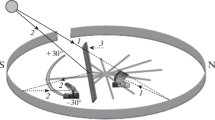Abstract
We describe the technique and results of modelling the solar radio emission during the maximum phase of the solar eclipse of March 29, 2006 on the RATAN-600. The aim of modelling is to refine the brightness temperature of the solar corona at the distances up to two solar radii from the center of the optical disk of the Sun. We obtained the distribution of brightness temperature in the vicinity of the coronal hole above the solar North Pole at the wavelength of 13 cm. The results of modelling showed that brightness temperatures of the coronal hole at the distances greater than 1.02 RC (here RC is the radius of the optical disk of the Sun) is substantially lower than the expected average brightness temperature of a typical coronal hole, and that of the quiescent Sun (below 30000 K) at the wavelength of 13 cm. The classical Baumbach-Allen formula for electron density in a spherically symmetric corona agrees with the results of observations starting at distances of (1.4–1.5) RC.
Similar content being viewed by others
References
O. A. Golubchina and G. S. Golubchin, Astrof. Issled. Izv. Spets. Astr. Obs. 14, 125 (1981).
V. M. Bogod, in Proceedings of All-Russian Solar-Physics Meeting (St. Petersburg, Russia, 2008), p. 63.
O. A. Golubchina, V. M. Bogod, A. N. Korzhavin, et al., Astrophysical Bulletin 63, 36 (2008).
V. M. Bogod, O. A. Golubchina, G. N. Zhekanis, et al., Astrophysical Bulletin 62, 379 (2007).
N. L. Reginald, O. C. St. Cyr, J. M. Davila, et al., Sol. Phys. 260, 347 (2009).
G. Z. Aizenberg, V. G. Yampol’skii, O. N. Tereshin, Antenny UKV (Ultrashort Waves Antennae) (Moscow, Svyaz, 1977) [in Russian].
V. V. Zheleznykov, Radioizluchenie Soltsa i planet (Radio Emission of the Sun and Planets (Moscow, Nauka, 1964) [in Russian].
V. V. Sobolev, Kurs teoreticheskoi astrofiziki (A Course in Theoretical Astrophysics) (Moscow: Nauka, 1967) [in Russian].
V. N. Borovik, M. Sh. Kurbanov, M. A. Livshits, and B. I. Ryabov, Astronom. Zh. 67, 1038 (1990).
V. N. Borovik, Lectures Notes in Physics, 432, 185 (1994).
O. A. Golubchina, Astrof. Issled. Izv. Spets. Astr. Obs. 21, 75 (1986).
O. A. Golubchina, Astrof. Issled. Izv. Spets. Astr. Obs. 21, 85 (1986).
Author information
Authors and Affiliations
Additional information
Original Russian Text © O. A. Golubchina, A. N. Korzhavin, S. Kh. Tokhchukova, 2011, published in Astrofizicheskii Byulleten, 2011, Vol. 66, No. 4, pp. 524–532.
Rights and permissions
About this article
Cite this article
Golubchina, O.A., Korzhavin, A.N. & Tokhchukova, S.K. Brightness temperature distribution in solar corona based on RATAN-600 observations of the maximum phase of the March 29, 2006 solar eclipse. Astrophys. Bull. 66, 488–495 (2011). https://doi.org/10.1134/S1990341311040110
Received:
Accepted:
Published:
Issue Date:
DOI: https://doi.org/10.1134/S1990341311040110




